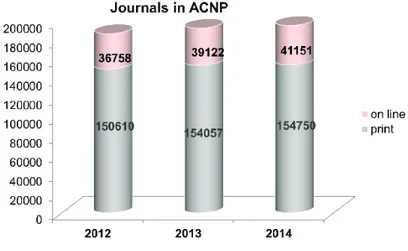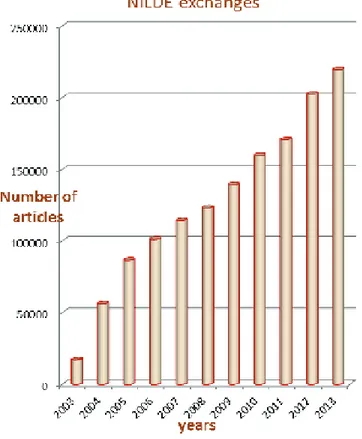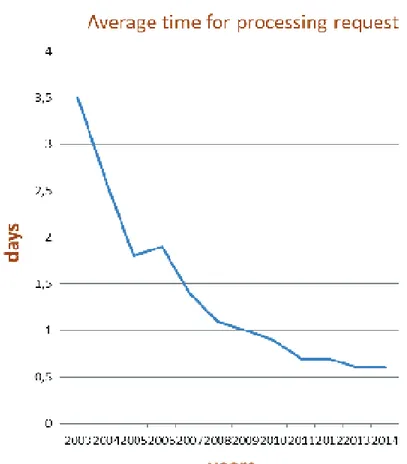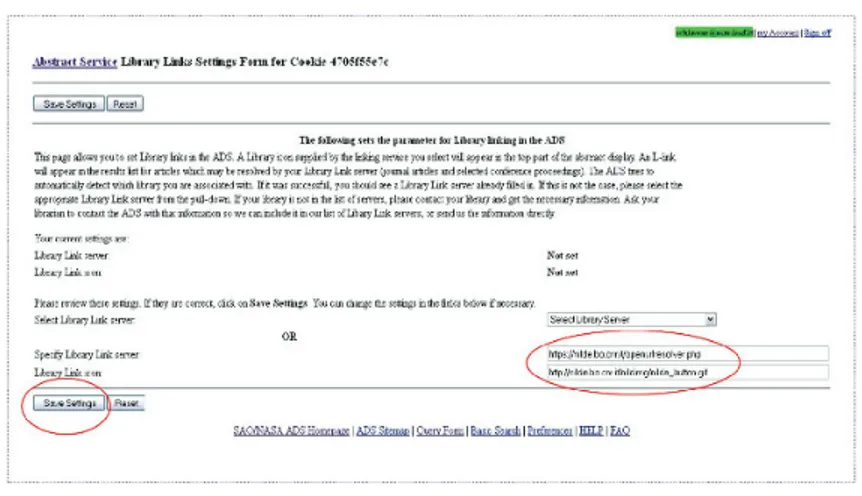2015
Publication Year
2020-03-30T10:55:29Z
Acceptance in OA@INAF
ACNP and NILDE: Essential Tools for Access to Scientific Research
Title
Brunetti, F.; Bonora, Orietta; Filippucci, Gustavo
Authors
http://hdl.handle.net/20.500.12386/23683
Handle
ASTRONOMICAL SOCIETY OF THE PACIFIC CONFERENCE SERIES
Series
492
A. Holl, S. Lesteven, D. Dietrich, and A. Gasperini, eds. c
2015 Astronomical Society of the Pacific
ACNP and NILDE: Essential Tools for Access to Scientific Research
Francesca Brunetti,1Orietta Bonora,2and Gustavo Filippucci2
1INAF – Arcetri Astrophysical Observatory, Florence, Italy 2University of Bologna, Italy
Abstract. This paper describes ACNP and NILDE, the two main Italian cooperative systems for access to scientific information. Used by the Italian Astronomical Libraries (IAL), they are two essential channels to access information resources that are otherwise unreachable. At the same time, they allow IAL (Italian Astronomical Libraries) to share their very rich and unique holdings with other research and university libraries.
1. ACNP and NILDE: aims and characteristics 1.1. ACNP (Italian Union Catalogue of Serials)
ACNP is a national union catalogue that contains bibliographic descriptions of Italian and international serials, both print and electronic, from libraries throughout Italy.1The
Catalogue was created in 1972 as a project of the National Research Council (CNR)2, the main Italian research institution, and now it is managed by the University of Bolo-gna and CNR itself.
The Catalogue is updated online by each library and includes all subject areas. To facilitate this process, in the 1990s ACNP acquired and stored the entire serials database from the ISSN International Centre3, an intergovernmental organization that aims to manage the International Serials Data System (ISDS) and which is an auto-matic recording system of serials publications. The ISSN International Centre assigns a standard number, called the International Standard Serial Number, that uniquely iden-tifies serials and this constitutes a valuable working tool for librarians who can use the identifier to capture bibliographic descriptions of serials not present in the Catalogue. ACNP users can also request the assignment of the ISSN standard number from the Italian ISSN Centre for the Italian journals not included in the Catalogue.
In addition to the internal information resources and the complete documenta-tion on periodicals, an archive of analytical entries was created and integrated with the ACNP Catalogue. It contains almost nine million articles, most of which are from the
1http://www.biblioteche.unibo.it/acnp For a comprehensive review of ACNP refer to: http://www.biblioteche.unibo.it/acnp/docs/manuali-e-documentazione/docs/ pubblicazioni-e-paper
2http://www.cnr.it/sitocnr/home.html 3http://www.issn.org/
276 Brunetti, Bonora, and Filippucci
ISI Current Contents4, and also analytical entries recorded by different bodies, as well as tables of contents entered directly by librarians. Besides the Catalogue, ACNP pro-vides a register of the participating libraries that contains detailed information about their services including Document Supply.
In summary, ACNP allows the user to:
• know the bibliographic data of Italian and international periodicals (both print and electronic);
• locate the periodicals owned by Italian libraries in the Catalogue and access the full text of digital documents, as well;
• consult the tables of contents of Italian and international periodicals, mainly in the area of science.
1.2. NILDE (Network Inter-Library Document Exchange)
NILDE5 is an online software for the service of Document Supply (Mangiaracina and Tugnoli 2012) and Inter-Library Loan around which a community of libraries has formed and is prepared to share their bibliographic resources in the spirit of reciprocal collaboration and, importantly, in a free manner. NILDE is therefore, both a web-based application and a network of libraries that share a particular innovative idea of service. Conceived in 2001 by the Library of the Area of CNR in Bologna, NILDE is currently used by over 860 Italian libraries (including recently added libraries from Greece and Spain) and approximately 24,000 registered users from the most important Italian uni-versities, public research, and health institutions.
In 13 years of activity, NILDE has processed 1.5 million document requests. NILDE allows the library to:
• manage, in an automated way, the procedures linked to Document Supply and Inter-Library Loan (DS-ILL);
• manage the consignment of the documents electronically across a secure web interface with a dedicated server, or by fax or ordinary mail, in compliance with the permitted uses;
• offer the users of the library a personalized service of Document Supply6; • obtain a report that is detailed and always updated with the exchanges carried
out between the libraries, with the possibility of measuring and comparing the performances of the various libraries or of the same library over time;
• automatically obtain the quality indicators “fill-rate” and “turnaround time”;
4http://thomsonreuters.com/current-contents-connect/
5https://nilde.bo.cnr.it/index.php. For a comprehensive review of NILDE refer to: https: //sites.google.com/site/nildeworld/approfondire-nilde/pubblicazioni
6Using the OpenURL protocol, implemented by NILDE, you can connect the most widely used biblio-graphic databases to NILDE, so that the user gets the automatic compilation of bibliobiblio-graphic citations in the NILDE request form.
• be a part of a network based on the sharing of good practices, tools, and policies for the continuous enhancement of the services of Document Supply and Inter-Library Loan (DS-ILL).
Within a few years, a community of libraries has grown around NILDE to share their bibliographic resources on the basis of mutual collaboration. The growth of the NILDE network has proved how great the need was in Italy for the adoption of stan-dardized processes by implementation of best practices for ILL services.
2. Data
The following data helps us to understand the dimensions of growth of ACNP and NILDE.
2.1. ACNP
Currently, about 2,000 Italian libraries of different types are included in the Catalogue. The most represented belong to academic and research areas, but private, health, associ-ations, foundassoci-ations, public, and ecclesiastical libraries are represented too. About 1,200 of these actively collaborate by entering and updating data online. The titles recorded in the Catalogue total over 195,000 and holdings records total over one million.
Figure 1. Journals in ACNP.
2.2. NILDE
There were 89 libraries participating in the network in 2003, and now they are 869 in May 2014. Of these, 730 (84.4%) belong to the ACNP at the same time.
The exchange of documents — mostly journal articles and parts or excerpts from books — is increasing in frequency, as shown in Fig. 2. In 2012 and in 2013, they exceeded 200,000 transactions per year.
Since 2002, NILDE exchanged nearly 1.5 million requests for documents. The exchange of documents follows the trend shown in Fig. 3, and marks a high level of growth in the efficiency of the service.
278 Brunetti, Bonora, and Filippucci 3. Models of functioning and financing
3.1. Functioning
The organizational models of ACNP and NILDE are similar and quite innovative in the Italian context. They point towards strong participation between the libraries associated with the services they provide. Both systems include user committees that are elected by the member libraries participating in activities through the establishment of working groups that represent specific needs. The respective committees also collect the needs of the target communities, offer new developments, and interact with the systems’ Ad-ministrators.
The libraries that are associated with the two systems are required to accept and comply with the rules of conduct laid down by the respective system’s guidelines and regulations. These include a set of organizational criteria that are intended to facilitate and support collaboration within the community of work and the system’s Administra-tors.
ACNP constituent bodies are represented by the Administrator and, from 2012, by the ACNP Libraries Committee (CBA). The ACNP Administrator has planned and
developed the software for the online management of the Catalogue since 1993, and later became the manager of the service as well.
The ACNP Libraries Committee remains in office for three years, and is composed of 18 members that represent the different types of participating libraries. It has the task of monitoring and analysing issues related to the activities of ACNP, offering solutions, participating actively in the development of the services, and making suggestions to improve the service.7
NILDE is based on a strong bottom-up approach. The NILDE Administrator (the CNR Research Area Library of Bologna) acts as a functional leader. From 2007, the NILDE Subscriber Assembly (ASN) — formed by the participating libraries — selects, by vote, a member for the NILDE Library Committee (CBN). CBN members and the Administrator collaborate by organizing open and dynamical working groups for
prob-7Linee guida per la cooperazione nel Catalogo Italiano dei Periodici (ACNP), http://www. biblioteche.unibo.it/acnp/Linee%20guida%20di%20ACNP
Figure 3. Average time for processing requests in NILDE 2003–2014 (source
280 Brunetti, Bonora, and Filippucci
lem solving8. The Committee has a term of three years and consists of 14 members representing the various types of libraries participating in the network. The Committee is a link with the users of the service and participates in communications with members through conferences/workshops and social networks, and monitors the actions of the network that support the adoption of best practices and surveys.
3.2. Financing
ACNP and NILDE have chosen a similar pattern of financing. The operation, develop-ment, maintenance, and technological equipment are supported by the libraries/instituti-ons participating in the services. Without such an indispensable contribution, the two systems could not exist. There is no public funding dedicated to the two systems. Sub-scriptions to the two systems are as an individual library or an organization/institution. The model permits support for the service by libraries paying an annual fee to cover administrative costs calculated in proportion to the number of participating libraries. The main feature of this model is to create a very tight bond between the suppliers and users of the services.
4. Two integrated services
From 2002, ACNP and NILDE have been collaborating and integrating their services and policies. By following the main steps of their partnership gives us a sense of their mutual growth. At the beginning of 2002, by searching in the ACNP catalogue, it was possible to determine the library that could provide the information resource with NILDE. Nowadays, there is a reciprocal connection between ACNP and NILDE. From NILDE, using the ISSN, we can identify the library in ACNP and also request the resource. This ensures efficiency in managing transactions and saves considerable time for both the operator and the end user (library to individual researcher).
Many other aspects of the services benefit by this integration. It provides economic benefits: ACNP and NILDE give some discounts in annual fees to the libraries that sub-scribe to both services. The integration between the two systems has produced a clear economic advantage for the participating libraries, as they are guaranteed a discount of 10%, which is applied to all the libraries/institutions that have joined in the previous year in both systems. Additionally, social meetings9and educational workshops,10 con-tribute to strengthen the projects and the sense of community. In fact ACNP and NILDE can be considered a real ecosystem. Libraries and librarians collaborate with each other in an interconnected manner, providing end users with increasingly sophisticated and dynamic services. This ecosystem, which is an open system, makes its services avail-able to the wider environment of scientific research and is one of the main actors in the scientific information system.
8For Rules and Regulations see: https://nilde.bo.cnr.it/learn.php?inc=rules 9https://sites.google.com/site/nildeworld/approfondire-nilde/convegni
10https://nilde.bo.cnr.it/ACNPworkshop/for ACNP and NILDE, a milestone in the reflection on the main aspects related to the development of electronic periodicals;
5. The role of ACNP and NILDE in the Italian context
ACNP and NILDE and their users communities represent the most important network for Italian libraries to share resources, services, and professional practices. Formed as a cooperative system, it works to provide access to scientific information that is often hampered by high costs and by restrictive policies in budgets. The organizations are considered by the libraries as a meeting point, a place for exchanges of best practices, and solutions to problems.
From 2000, ACNP and NILDE have been supporting networks and different pro-jects for library cooperation. They enhance library cooperation by giving users the possibility to make their services more integrated. They provide more visibility to these resources, thereby making them more accessible.
Among them, we mention the experience of the Italian astronomical libraries (IAL), which have had their holdings merged into one sub-catalogue called ACNP AS-TRONOMICO11: this derived sub-catalogue contains all the journal holdings of the Italian astronomy libraries. We mention also BIBLIOSAN,12 which is the network of the National Health System and BESS,13the electronic library of Social Sciences and Economics of the Piedmont region. These projects belong to different disciplines and were developed in response to similar needs: to unify, to enhance services and pro-fessional practices, and to make documents accessible. A new project ALPE (License Archive for Electronic Journals), created to support librarians and help them adhere to the license clauses for Document Delivery (DD) and Inter-Library Loan (ILL) of electronic resources, is also moving in the same direction.
6. How Italian astronomical libraries use ACNP and NILDE
Before we analyze how our libraries are using specific tools for ILL and DD services, it is important to remember that traditionally, in Italy, most of the information resources of astronomy, including monographs and journals (print and online), were found in the libraries of astronomical observatories, rather than in university libraries. The relation-ship between the astronomical libraries with ACNP and NILDE is connected with the recent administrative developments in Italian astronomy. The changes in the organi-zation of the Italian astronomical institutions were reflected in Astronomical libraries. Until 2002, each Italian Observatory was an independent research institution, with dis-tinct history, heritage, dimension, and scientific activity. Now, twelve Observatories and five research Institutions have been merged to form the Istituto Nazionale di Astrofisica – INAF (National Institute for Astrophysics).
The Italian astronomical libraries have been working as a network for 90 years now, sharing information resources, services, and work practices. Since the creation of INAF, they have formalized their union, becoming members of Servizio Biblioteche e Archivi Storici dell’INAF (INAF Library and Historical Archives Service). At the start of INAF, most of the astronomical libraries had been using ACNP and have had entered
11http://acnp.unibo.it/catalogo/astro 12http://acnp.unibo.it/catalogo/sanita 13http://acnp.unibo.it/catalogo/bess
282 Brunetti, Bonora, and Filippucci
all their holdings into ACNP ASTRONOMICO (Italian Astronomy Libraries Serials Catalogue).
This sub-catalogue, derived from ACNP, is accessible from the webpages of each INAF library and from the webpage of INAF Library and Historical Archives Service. Containing 2,689 journals and 95 online resources, it represents one of the first attempts to share all the information resources across the astronomical libraries. The “history” of the relationship between IAL and NILDE is similar to that with ACNP. At the begin-ning, every single library subscribed to NILDE separately, then, after the start of INAF Library and Historical Archives Service, IAL subscribes to NILDE as one institution.
The analysis of global NILDE exchanges permit us to say something about the use of ACNP and NILDE by IAL. First, the exchanges are not currently high but are progressively increasing. In 2011, IAL exchanged 480 articles; in 2012, the number was 537 and in 2013, it was 568. Second, IAL are working more as suppliers. Most of the articles which IAL is supplying to the other libraries belong to the Engineering, Physics, Astronomy, and Earth Sciences categories. Engineering (SPIE collection used in technological research) is the main category for lending. Third, borrowing represents a little more than half of the quantity of exchanges. Physics and Earth Sciences articles are the most requested categories here.
Among Italian astronomical libraries, ACNP and NILDE are the most important channels for requesting DD of non-astronomical subjects (such as Physics and Geo-physics). They allow libraries to locate and furnish information not easily accessible to the astronomers.
For astronomical papers, the primary sources that fulfill the needs of the astronom-ers are the web resources like the ADS and arXiv.org. But NILDE offastronom-ers the usastronom-ers of the library a personalized service of Document Supply: using the OpenURL protocol, im-plemented by NILDE, the user can link NILDE with ADS (Figure 4) and automatically compiles the bibliographic citations for the user in the NILDE request form.
Figure 4. NILDE OpenURL Protocol in ADS
NILDE is also a tool for journal subscription, renewal, and cancellation. Through the reports generated by NILDE, it is possible to know the exchanges made by each single IAL and of INAF as a whole. A function that allows for the analysis of trends in sharing resources is planned for the future. For IAL, the cost of both services is not
high: annual institutional subscription costs are 2,000 euros for ACNP and 1,000 euros for NILDE. The benefits certainly outweigh the costs.
7. Conclusions
Are ACNP and NILDE important for IAL? Yes, for many reasons. They make acces-sible the holdings of IAL to all the other libraries. They allow libraries to locate and furnish information not easily accessible to the astronomers. Finally, they represent a means for the collaboration and for sharing resources between libraries.
References
Mangiaracina, S., Tugnoli, A. 2012, Interlending & Document Supply, 40, (2), 88



